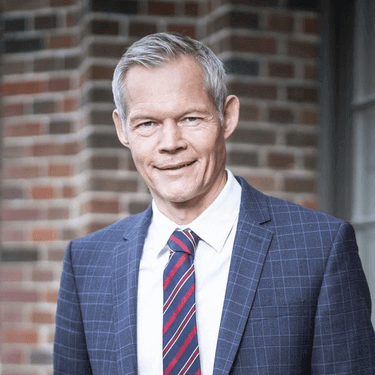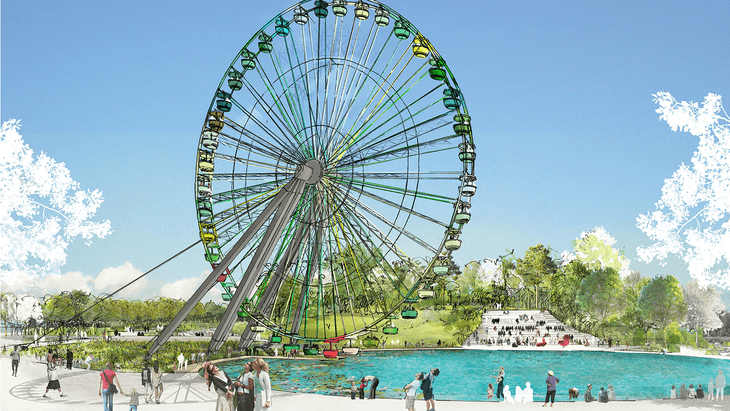"In order to move cities forward, it is immensely important that we work and think with an intersectoral approach."
USE:POSITIONS with Christoph Schmidt
Christoph Schmidt is Managing Director of Grün Berlin GmbH and chairman of Grün Berlin Stiftung, a company dedicated to climate-friendly and climate-resilient development in Berlin. In this use:positions interview, our use community and content manager Anne Schmidt asks him about Grün Berlin's mission and projects in Berlin – and about the future of urban open spaces.
Who are you and what do you do?
My name is Christoph Schmidt, I am managing director of Grün Berlin GmbH and chairman of Grün Berlin Stiftung. I also act as a partner for several subsidiaries of our company. I am originally a trained landscape architect and a specialist engineer for project development. This qualified me to work for several years as a division manager for HafenCity Hamburg (Europe’s largest inner-city urban development area) , and in 2008, I joined Grün Berlin.

© Dominik Butzmann
What is Grün Berlin and what is your mission?
Grün Berlin is a company owned by the state of Berlin, operating in the fields of climate-resilient urban redevelopment, the development, realization and operation of green urban spaces, and the development of sustainable transport infrastructure. And that makes us unique, in Germany at least. We are involved in issues of urban development that are very future-oriented. This makes our work incredibly exciting and valuable. Frankly, it is a central motivation of all those who work for us - there are now over 270 employees.
Can you summarize in a few sentences what the ideal future of Berlin would look like for you – professionally and personally?
First of all, there is the task of changing directions for urban planning and development. From my point of view, in order to move cities forward, it is immensely important that we work and think with an intersectoral approach. Up to this point, municipal work has been characterized by thinking in silos. That’s very obstructive. I think that one crucial task for the future will be to organize interdisciplinary and collaborative methodologies and to implement them into professional management structures. The methods we have used so far are slowing us down and far too much time and capacity is wasted in the process.
How can city makers and city planners ensure equal access to public space? How does urban development relate to concerns of climate justice and transformation?
I would say that climate justice means environmental justice, but it also means social justice. Accessibility to public spaces is, I think, a very social issue. What barriers do you create? Do users come from all areas of the urban spectrum? How do you avoid focusing on only a few user groups that are strong, loud, that can hold their own, so to speak, and also give a chance to those who may not be so strong? How do you promote the theme of integration in the context of urban spaces? These are all crucial social aspects that are often neglected in urban or green space development.
Let me give an example: At least one third of all residents in Berlin live along noisy streets. If we manage not only to make these streets quieter, but also to increase the share of bicycle infrastructure, to reduce gas emissions and noise, then of course that brings environmental justice and an improvement of the quality of life for those who live there. I think that is precisely how an intersectoral approach works: it contributes not only to climate protection, but also to social justice.

© Thomas Rosenthal
I was just thinking about Platz der Luftbrücke…
Exactly, that's right. This is a prime example of a project where all aspects of the transformation towards a green, socially and environmentally just city come together. At Platz der Luftbrücke, we restore a garden monument, and we rebuild and reduce streets. Bicycle traffic infrastructure will be accommodated, which will lead to a strengthening of the retail trade. The project includes rainwater management, which serves the supply of the plants and the trees. We will install mist nozzles on the forecourt of the building, which will lead to an improvement of the micro climate. And the quality of life for the residents will also increase, because neighborhood squares are being created with new recreational qualities, playgrounds, social spaces, and lounges. All this makes Platz der Luftbrücke an exemplary cross-sectoral project that we have been working on intensively for a good four years.
Could you tell us something about the development of Spreepark?
Spreepark has an unbelievable iconographic value. Especially those who grew up in the former GDR identify with it, as it was more or less the only large amusement park there. Many emotions are attached to the place. We wondered: How can you develop this park without lapsing into folksiness and romanticism? We set out to look across Europe to find comparable projects, and found one in Nantes. The city’s former port industry is revived with art projects. This functioned as a blue print for our development of Spreepark.
Spreepark is being developed with the citizens. Participation is thus a key driver for change. For us, this was yet another new method of project development, and we will be able to see in the future what will come of it. Again, the intersectoral approach that we try to establish added value to every infrastructure measure in the park. The Ferris wheel, for example, is not just a Ferris wheel, but a major art project. It hangs over a large water surface, a spectacular suspension, statically quite interesting. At the same time there is a retention area where the water is absorbed and evaporates. Biotopes are created. Everyone is anticipating the opening of Spreepark!

© Grün Berlin GmbH
To what extent has the pandemic affected your work? Will it change planning and development of park design or public space in the future?
Yes, I have two observations. One, our parks were overflowing during the pandemic. Two, a lot of people were cycling and taking the subway. The conclusion is: we need to do more for bike infrastructure and for mobility transition and for the development and maintenance of our public spaces and parks.
Because everything that couldn't take place indoors took place outdoors during the pandemic, it led to overuse and crowdedness in parks and publics spaces. Even now, the number of visitors is increasing. Together with the Institute for Ecological Economy Research (IÖW), we conducted a study that aimed at determining how much it is worth to users and citizens to have a well-maintained park. The figures and findings of this study are very interesting. For now, all we can say is: If people are willing to contribute their own money to develop and maintain parks and public spaces, then you can see how important these facilities have become.
Maybe we could introduce a park tax...
Yes. If you at least knew that taxes were earmarked to benefit green spaces as well, or if it was as simple as being used for removing garbage. These are fees that are levied, and no one complains about them, because of course no one wants a littered street or a littered house. Then, of course, we would be a good deal further ahead, but unfortunately, the political discussion about this has not yet started and it will be difficult to implement.
And now for our final question: Do you know whether the work of Grün Berlin influences other cities? Have you had visits from delegations from other cities or regions?
Yes, regularly, many. European metropolises regularly ask us and would like to be guided and have explained how we work, why we exist and in what capacity we work directly with the City of Berlin and what benefits there are. We have also received enquiries from Eastern European countries as well as from France, England, Great Britain, Korea, USA. The level of interest in our work methods and projects is really very high.
USE: POSITIONS is a dynamic series of interviews featuring citymakers from the global use community.